Abstract
A series of Rh-negative primiparae has been studied in order to gain further insight into the process of immunization by pregnancy. The distribution of foetal cell counts in blood samples taken after delivery was determined for 2,029 mothers giving birth to ABO-compatible babies and for 417 mothers with ABO-incompatible babies.
A total of 760 mothers were tested for the development of Rh antibodies six months after the delivery of an ABO-compatible Rh-positive baby and 236 were further followed up through a second Rh-positive pregnancy. The incidence of anti-D six months after delivery is estimated to be 8.5%, and there is evidence of a direct relation between the count of foetal cells after delivery and the risk of developing antibodies. A further 8.5% of mothers were estimated to develop anti-D by the end of the second pregnancy, and it is postulated that these individuals had been primed by the first pregnancy. There is some evidence that the larger stimuli of Rh-positive blood in the first pregnancy are more likely to result in overt antibody formation, while the smaller stimuli are more likely to prime, antibodies not being detected until a second stimulus occurs during the second pregnancy.
These findings are relevant to the programme for preventing Rh-immunization by injecting anti-D gammaglobulin.
Full text
PDF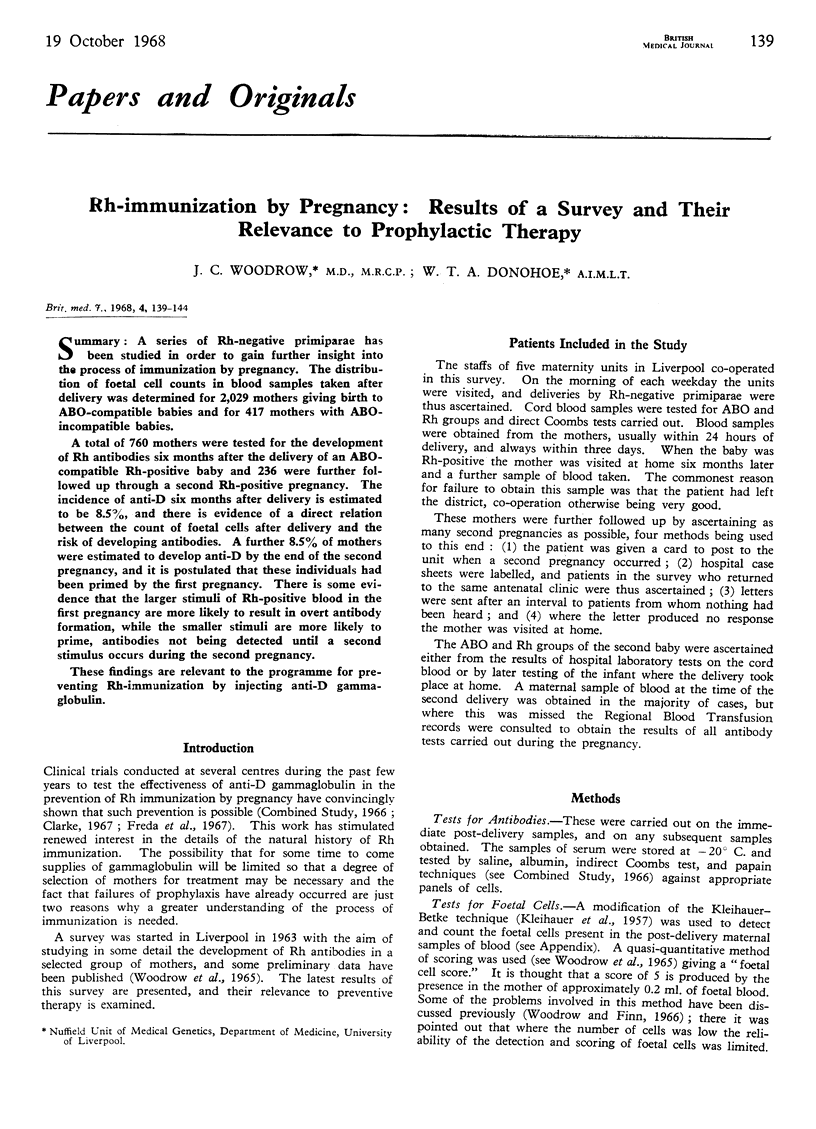
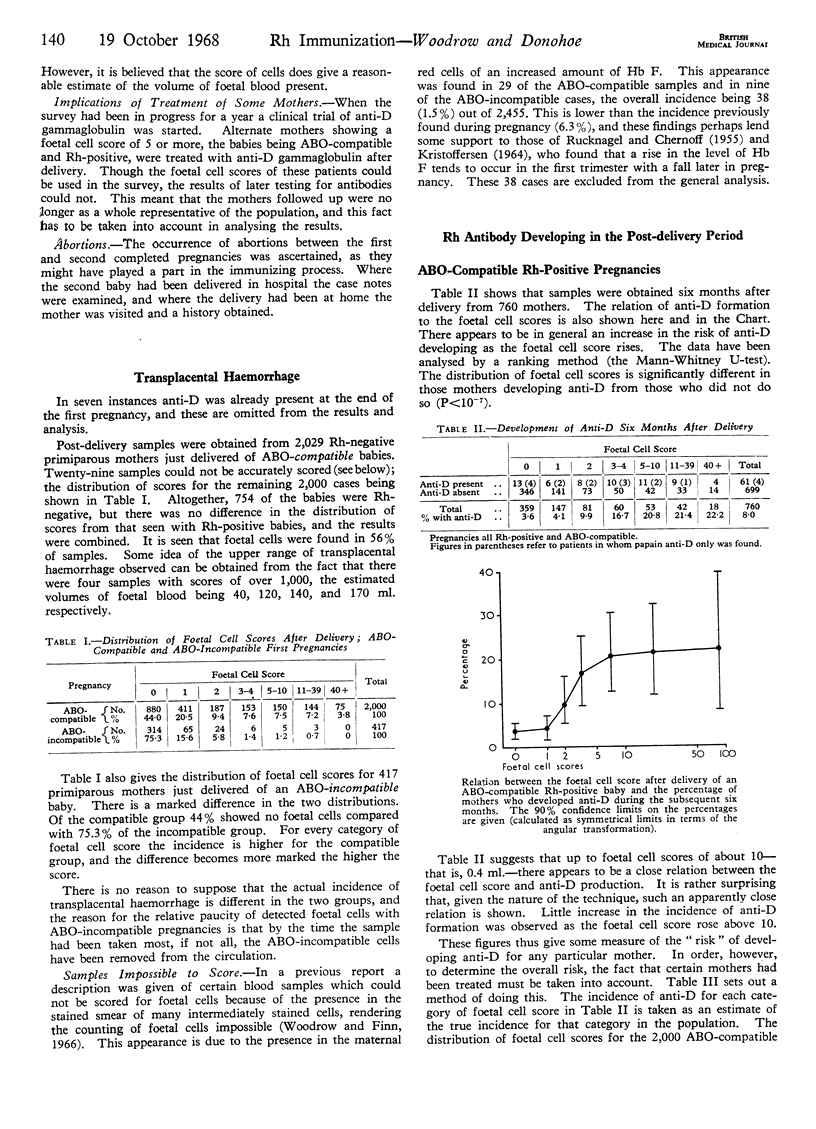
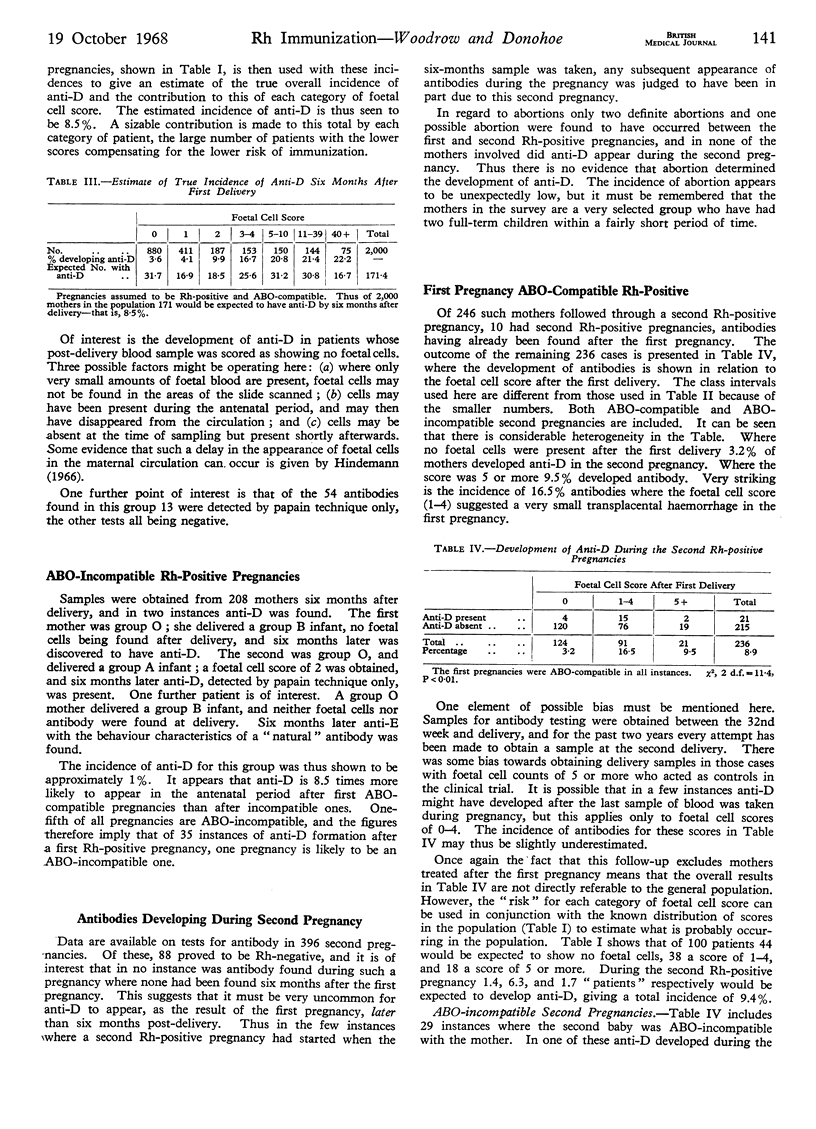
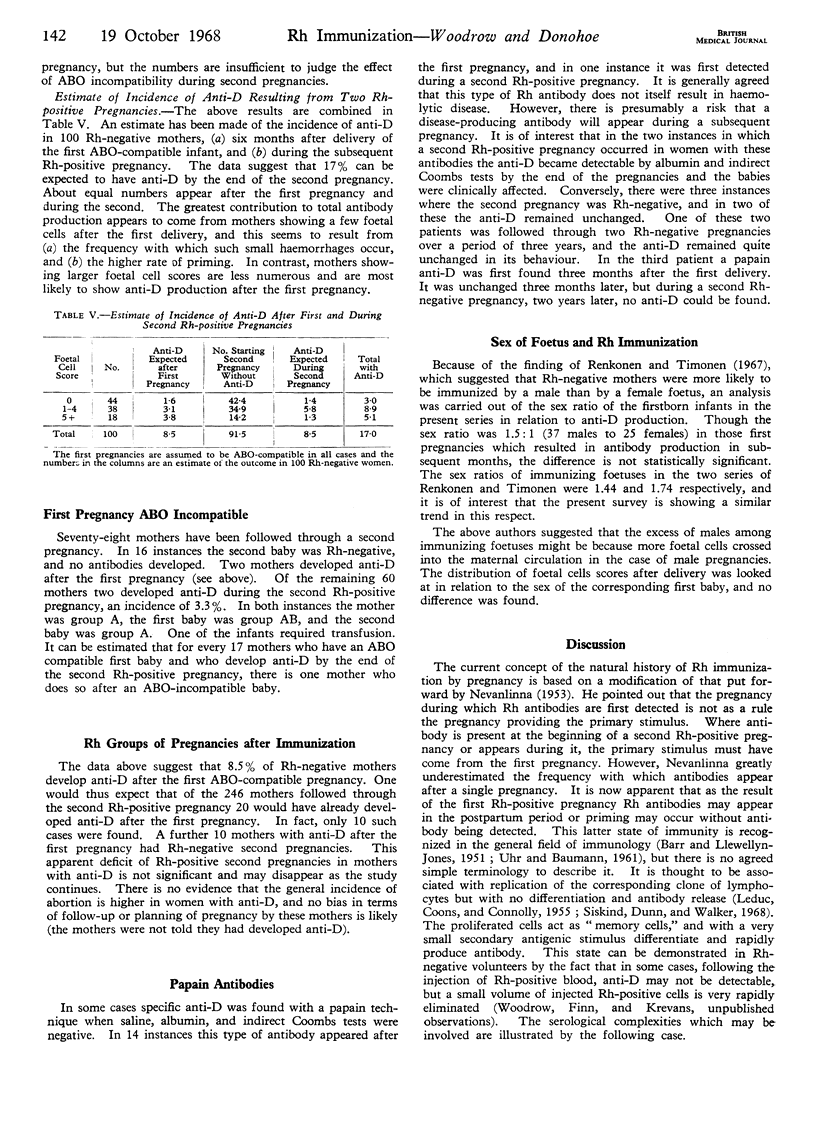
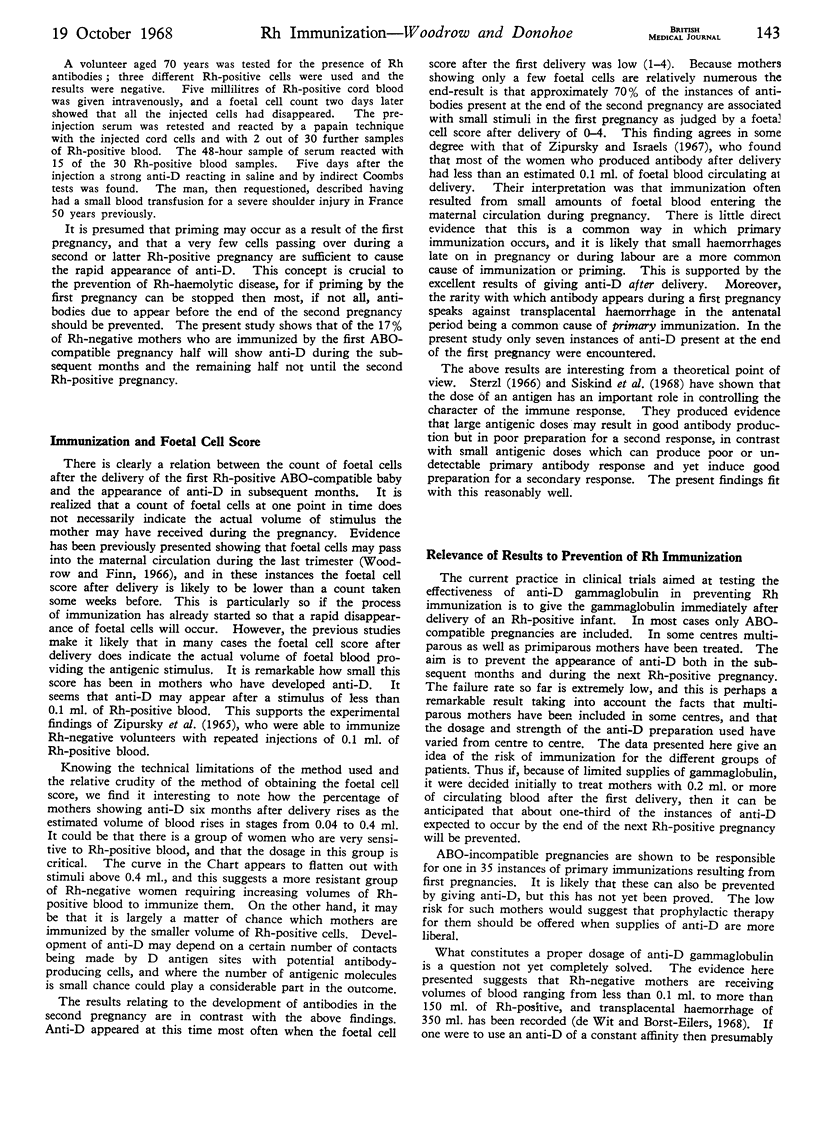
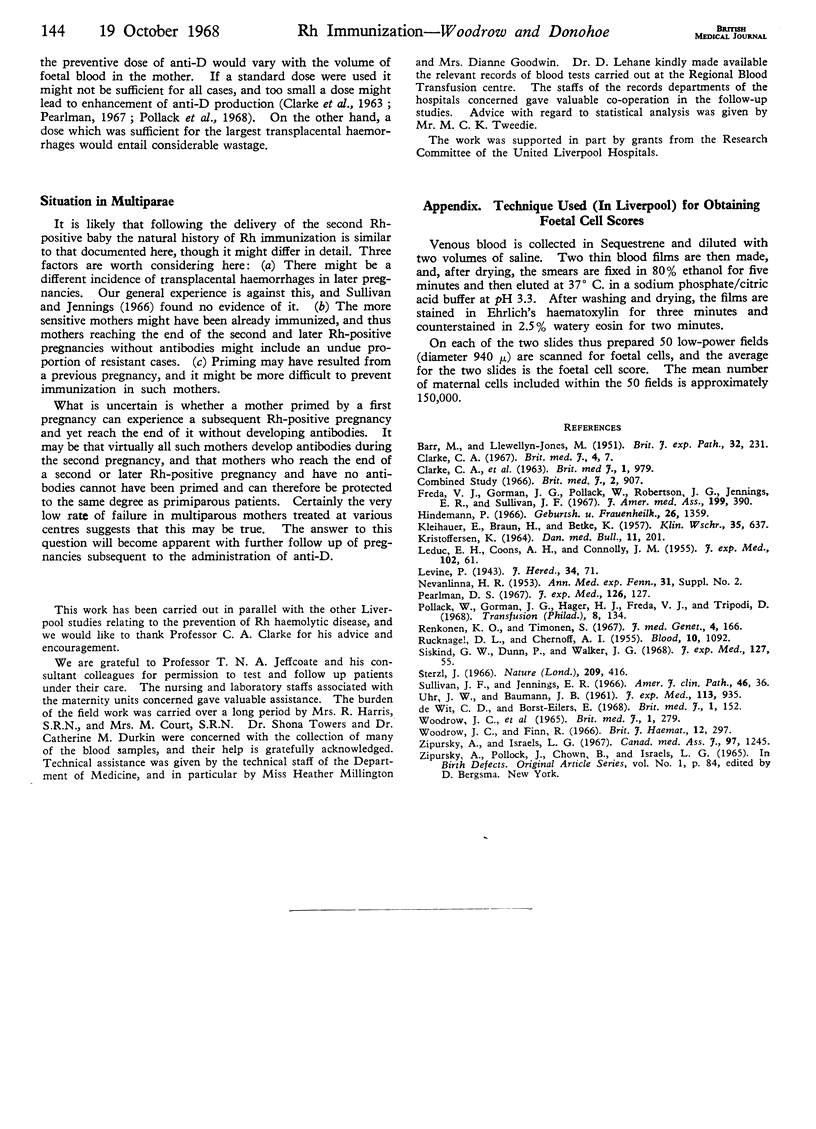
Selected References
These references are in PubMed. This may not be the complete list of references from this article.
- BARR M., LLEWELLYN-JONES M. Factors influencing the development of potential immunity and the character of the secondary response. Br J Exp Pathol. 1951 Jun;32(3):231–245. [PMC free article] [PubMed] [Google Scholar]
- Clarke C. A. Prevention of Rh-haemolytic disease. Br Med J. 1967 Oct 7;4(5570):7–12. doi: 10.1136/bmj.4.5570.7. [DOI] [PMC free article] [PubMed] [Google Scholar]
- Freda V. J., Gorman J. G., Pollack W., Robertson J. G., Jennings E. R., Sullivan J. F. Prevention of Rh isoimmunization. Progress report of the clinical trial in mothers. JAMA. 1967 Feb 6;199(6):390–394. doi: 10.1001/jama.199.6.390. [DOI] [PubMed] [Google Scholar]
- Hindemann P. Experimentelle und klinische Untersuchungen über eine transabdominale Späteinschwemmung fetaler Erythrozyten in den mütterlichen Kreislauf 9neue Aspekte der Rhesussensibilisierung) Geburtshilfe Frauenheilkd. 1966 Oct;26(10):1359–1372. [PubMed] [Google Scholar]
- KLEIHAUER E., BRAUN H., BETKE K. Demonstration von fetalem Hämoglobin in den Erythrocyten eines Blutausstrichs. Klin Wochenschr. 1957 Jun 15;35(12):637–638. doi: 10.1007/BF01481043. [DOI] [PubMed] [Google Scholar]
- KRISTOFFERSEN K. THE DIAGNOSTIC SIGNIFICANCE OF ALKALI-RESISTANT HAEMOGLOBIN IN MATERNAL BLOOD DURING PREGNANCY AND DELIVERY. Dan Med Bull. 1964 Nov;11:201–208. [PubMed] [Google Scholar]
- Pearlman D. S. The influence of antibodies on immunologic responses. I. The effect on the response to particulate antigen in the rabbit. J Exp Med. 1967 Jul 1;126(1):127–148. doi: 10.1084/jem.126.1.127. [DOI] [PMC free article] [PubMed] [Google Scholar]
- Pollack W., Gorman J. G., Hager H. J., Freda V. J., Tripodi D. Antibody-mediated immune suppression to the Rh factor: animal models suggesting mechanism of action. Transfusion. 1968 May-Jun;8(3):134–145. doi: 10.1111/j.1537-2995.1968.tb04891.x. [DOI] [PubMed] [Google Scholar]
- RUCKNAGEL D. L., CHERNOFF A. I. Immunologic studies of hemoglobins. III. Fetal hemoglobin changes in the circulation of pregnant women. Blood. 1955 Nov;10(11):1092–1099. [PubMed] [Google Scholar]
- Sterzl J. Immunological tolerance as the result of terminal differentiation of immunologically competent cells. Nature. 1966 Jan 22;209(5021):416–417. doi: 10.1038/209416a0. [DOI] [PubMed] [Google Scholar]
- Sullivan J. F., Jennings E. R. Transplacental fetal-maternal hemorrhage. Am J Clin Pathol. 1966 Jul;46(1):36–42. doi: 10.1093/ajcp/46.1.36. [DOI] [PubMed] [Google Scholar]
- UHR J. W., BAUMANN J. B. Antibody formation. I. The suppression of antibody formation by passively administered antibody. J Exp Med. 1961 May 1;113:935–957. doi: 10.1084/jem.113.5.935. [DOI] [PMC free article] [PubMed] [Google Scholar]
- WOODROW J. C., CLARKE C. A., DONOHOE W. T., FINN R., MCCONNELL R. B., SHEPPARD P. M., LEHANE D., RUSSELL S. H., KULKE W., DURKIN C. M. PREVENTION OF RH-HAEMOLYTIC DISEASE: A THIRD REPORT. Br Med J. 1965 Jan 30;1(5430):279–283. doi: 10.1136/bmj.1.5430.279. [DOI] [PMC free article] [PubMed] [Google Scholar]
- Woodrow J. C., Finn R. Transplacental haemorrhage. Br J Haematol. 1966 May;12(3):297–309. doi: 10.1111/j.1365-2141.1966.tb05636.x. [DOI] [PubMed] [Google Scholar]
- Zipursky A., Israels L. G. The pathogenesis and prevention of Rh immunization. Can Med Assoc J. 1967 Nov 18;97(21):1245–1257. [PMC free article] [PubMed] [Google Scholar]
- de Wit C. D., Borst-Eilers E. Failure of Anti-D Immunoglobulin Injection to Protect against Rhesus Immunization after Massive Foeto-maternal Haemorrhage. Report of 4 Cases. Br Med J. 1968 Jan 20;1(5585):152–154. doi: 10.1136/bmj.1.5585.152. [DOI] [PMC free article] [PubMed] [Google Scholar]


